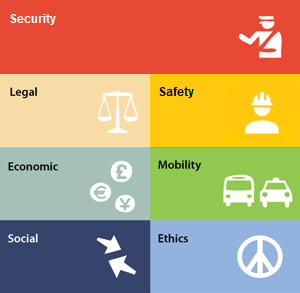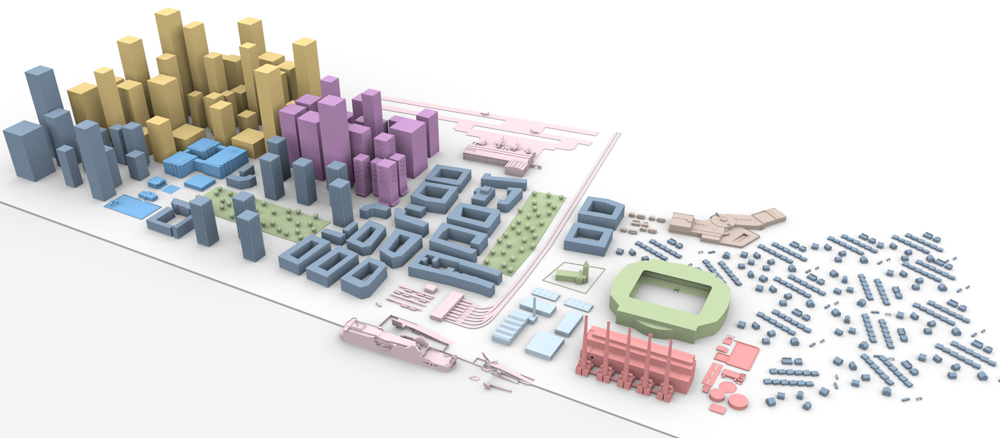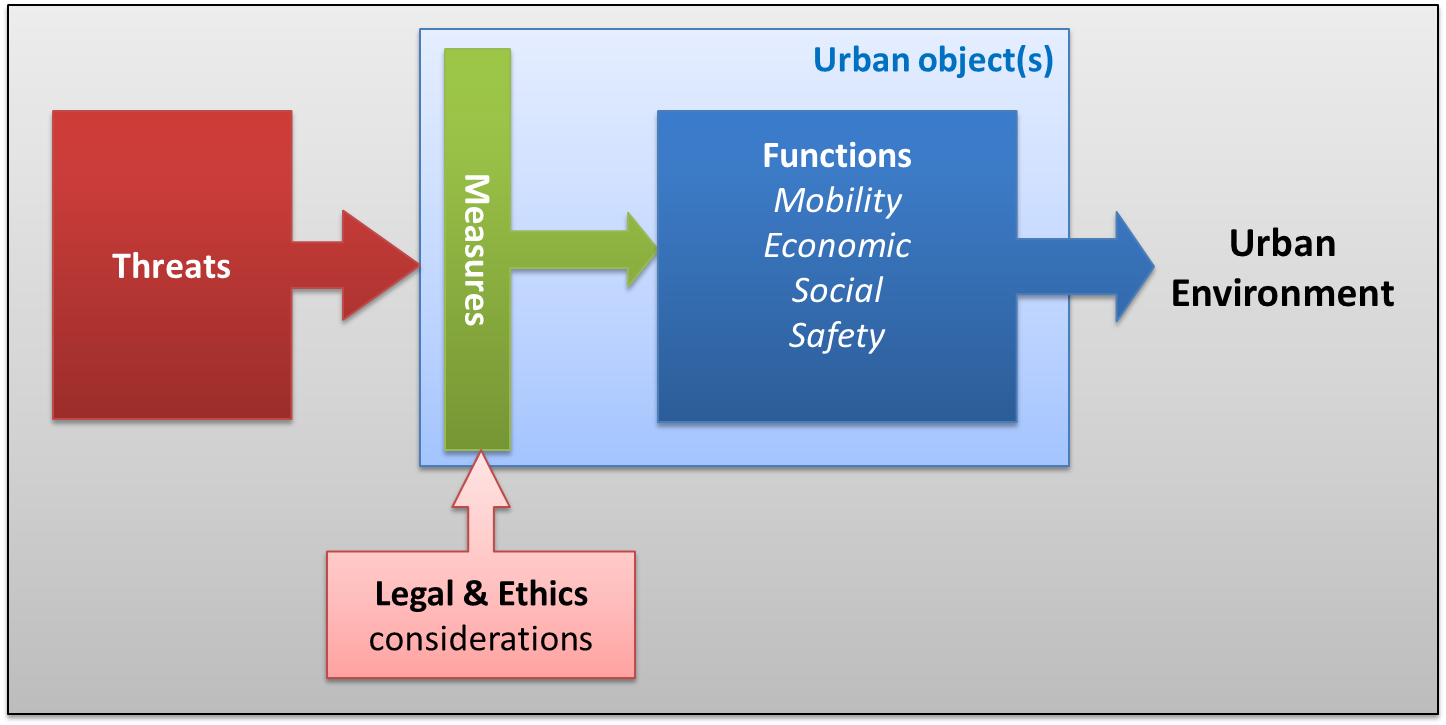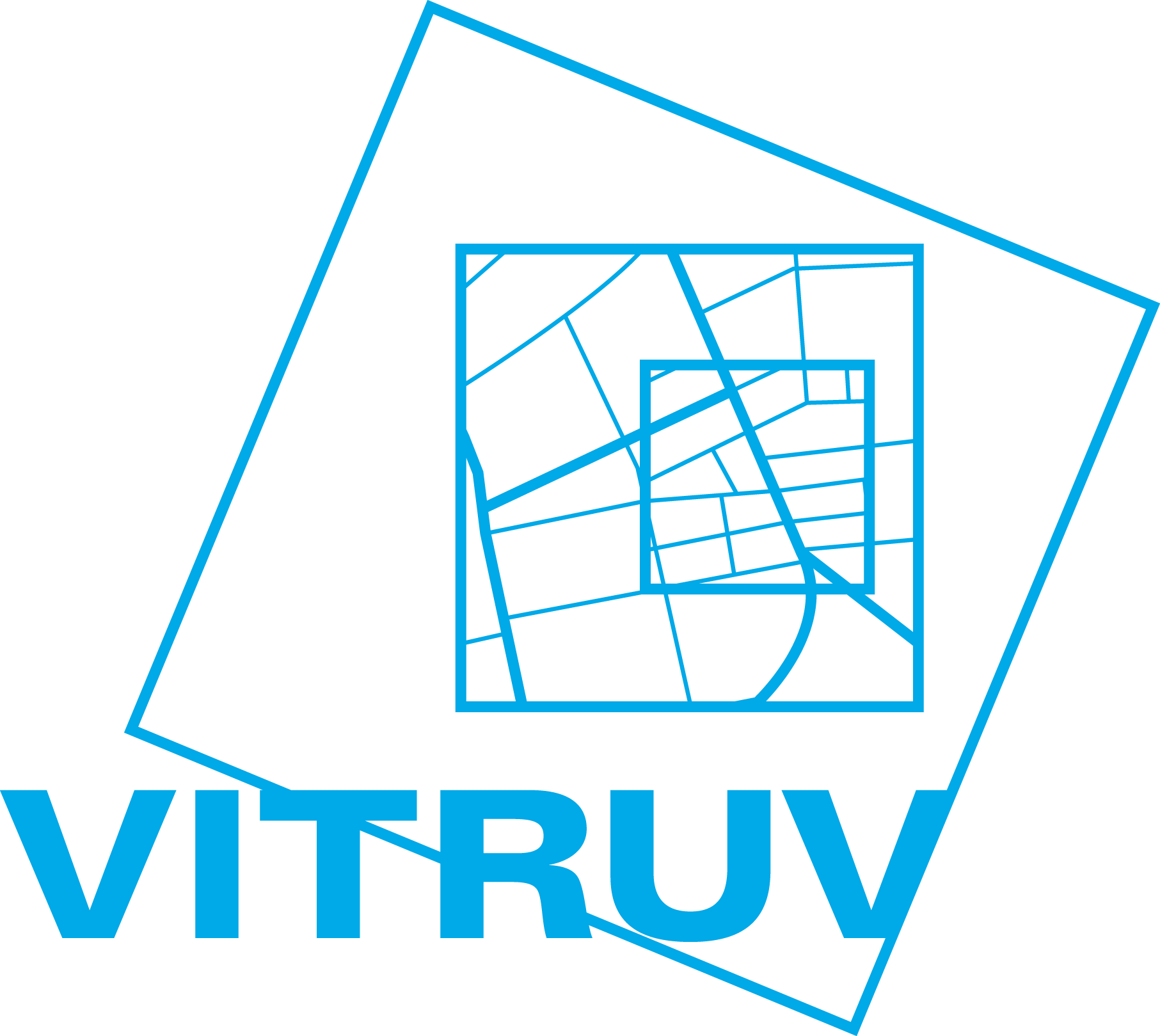Difference between revisions of "Welcome to Urban Securipedia"
| (160 intermediate revisions by 6 users not shown) | |||
| Line 1: | Line 1: | ||
| + | Urban Securipedia is an urban [[safety]] and [[security]] knowledge base for local government and other organisations responsible for or involved in the safety and security of people and objects in the urban area. Examples of Securipedia users are: [[Urban planner|urban planners]], municipality staff and law enforcement agencies responsible for the security of public space, and public event planners. |
||
| − | [[Category:Top category]] |
||
| + | Urban Securipedia provides a structured approach to managing risk, providing practical tools for security concept development, security risk assessment and security technology evaluation, among others. |
||
| − | = {{PAGENAME}} = |
||
| + | The knowledge within Urban Securipedia can be accessed either by selecting the aspect of interest, the urban area of interest or simply by searching for a keyword:<center> |
||
| − | Securipedia is an [[Security|urban security]] (and connected [[Safety|safety]]) [[knowledge base]] which forms part of a complimentary tool with the objective of assisting and supporting the [[urban planner]] to make more informed deliberations and decisions on the [[proper planning and sustainable development]] of the urban area, from a security (and connected safety) perspective.<br /> |
||
| + | {| style="border-collapse: collapse; border-spacing: 0; border-width: 0px; border-style: solid; border-color: lightgray; padding: 0; width:900px" |
||
| + | |- |
||
| + | ! style="background: darkgray; border: 6px solid lightgray;" width="300" |Enter by aspect<br><small>(select from below)</small> |
||
| + | ! style="background:darkgray; border: 6px solid lightgray;" width="500" |Enter by [[urban object|urban object]] type<br><small>(hover over different land uses below)</small> |
||
| + | ! style="background:darkgray; border: 6px solid lightgray;" width="100" |Enter by specific keyword<br><small>(as per top right of screen)</small> |
||
| + | |- |
||
| + | ! style="background: lightgray; border: 6px solid lightgray;" |<imagemap> |
||
| + | Image:funcissues-2.png|300px| |
||
| + | poly 2 4 296 4 297 71 5 71 4 5 [[Security|Security]] |
||
| + | poly 2 76 147 76 148 143 5 143 4 76 [[Legal|Legal]] |
||
| + | poly 3 149 147 149 148 216 5 216 4 150 [[Economic|Economic]] |
||
| + | poly 3 222 147 222 148 289 5 289 4 223 [[Social aspects|Social]] |
||
| + | poly 152 76 296 76 297 143 154 143 153 77 [[Safety|Safety]] |
||
| + | poly 152 149 296 149 297 216 154 216 153 150 [[Mobility|Mobility]] |
||
| + | poly 152 222 296 222 297 289 154 289 153 223 [[Ethics|Ethics]] |
||
| + | desc none |
||
| − | === Background to Securipedia...VITRUV === |
||
| + | </imagemap> |
||
| + | ! style="background: white; border: 6px solid lightgray;" |<imagemap> |
||
| − | [http://www.vitruv-project.eu/ VITRUV] (Vulnerability Identification Tools for Resilience Enhancements of Urban Environments) is a project co-funded by the European Commission within the Seventh Research Framework Programme 2007-2013. This collaborative project seeks to incorporate appropriate security measures for [[vulnerability]] identification and [[resilience]] enhancements in [[urban planning]] practice. |
||
| + | Image:Clickmap.png|500px| |
||
| + | poly 41 61 56 69 75 123 102 121 133 121 139 126 156 162 104 202 76 196 13 178 3 130 32 115 24 74 [[Residential|Residential]] |
||
| − | While [[urban planning]] is a complex process with many [[stakeholders]] and [[Urban planner|multi-disciplinary teams]], the existing software tools do not include any comprehensive consideration of [[security]] (and connected [[safety]]) aspects of [[urban planning]] as a whole.<br /> |
||
| + | poly 251 152 205 131 159 158 135 121 73 120 68 89 115 60 114 39 164 7 261 17 311 40 319 93 305 89 278 107 278 134 [[Office|Offices]] |
||
| + | poly 141 225 99 205 207 135 251 157 [[Public services and facilities|Public services and facilities]] |
||
| + | poly 215 182 330 220 304 242 186 199 [[Social facilities, open and civic space|Social facilities, open and civic space]] |
||
| + | poly 140 229 366 303 402 273 488 302 510 274 475 260 529 182 437 161 395 207 369 200 263 150 220 180 331 221 304 243 182 200 [[Residential|Residential]] |
||
| + | poly 319 345 514 411 548 374 358 306 [[Transportation|Transportation (Port)]] |
||
| + | poly 528 184 567 192 511 274 476 260 [[Social facilities, open and civic space|Social facilities, open and civic space]] |
||
| + | poly 389 206 280 153 280 110 307 90 323 93 325 76 377 88 386 115 416 119 422 111 437 114 439 153 [[Mixed Use|Mixed use]] |
||
| + | poly 762 427 996 377 939 226 699 251 670 235 616 236 628 204 587 195 557 242 626 257 714 272 735 292 729 324 780 352 761 380 [[Residential|Residential]] |
||
| + | poly 803 238 702 249 664 233 668 210 702 210 774 202 [[Retail and commercial services|Retail (Shopping centre)]] |
||
| + | poly 757 426 756 378 769 353 726 332 702 361 697 393 700 418 [[Utilities|Utilities (water)]] |
||
| + | poly 599 313 705 346 733 287 698 269 626 259 610 280 [[Social facilities, open and civic space|Sports facilities]] |
||
| + | poly 618 259 556 248 533 282 591 297 [[Social facilities, open and civic space|Church]] |
||
| + | poly 598 303 529 281 480 337 557 362 [[Industry|Industry]] |
||
| + | poly 375 306 478 340 629 133 613 128 491 301 400 279 [[Transportation|Transportation (Rail)]] |
||
| + | poly 604 132 564 185 444 160 440 114 422 106 413 117 386 112 385 97 [[Transportation|Transportation (Airport)]] |
||
| + | poly 629 205 616 233 661 233 666 218 [[Retail and commercial services|Out of town retail]] |
||
| + | poly 561 367 697 414 699 355 588 318 [[Utilities|Utilities]] |
||
| + | desc none |
||
| − | === Concept, Plan and Detail Level === |
||
| + | </imagemap> |
||
| + | ! style="background: white; border: 6px solid lightgray;" |Search by specific keyword: <inputbox> |
||
| + | type=search |
||
| + | width=40 |
||
| + | </inputbox> |
||
| + | |- |
||
| + | |} |
||
| + | </center> |
||
| + | |||
| − | The urban planning process evolves from a rough, basic concept to a detailed, concrete design, and the VITRUV project provides tools for urban planning which can be applied across three stages of design, ranging from [[Concept level|concept]] to [[Plan level|plan]] to [[Detail level|detail]] level. Securipedia forms part of the toolkit applicable to the concept level, where well-considered systematic qualitative decisions should be made.<br /> |
||
| + | Securipedia offers information about a range of topics related to urban safety and security. Its structure is represented graphically below, and more can be learned [[Structure of the knowledge base|here]]. |
||
| − | <br> |
||
| + | <center> |
||
<imagemap> |
<imagemap> |
||
| − | Image: |
+ | Image:Schema_contents_wiki.png|800px |
| + | rect 50 109 293 419 [[Threat]] |
||
| − | circle 171 168 131 [[Concept level|concept level]] |
||
| + | rect 443 47 510 450 [[Measures]] |
||
| − | circle 411 167 119 [[Plan level|Plan level]] |
||
| + | rect 327 552 473 677 [[Legal aspects]] |
||
| − | circle 661 165 140 [[Detail level|detail level]] |
||
| + | rect 475 552 633 681 [[Ethics|Ethics aspects]] |
||
| + | rect 768 180 913 220 [[Mobility]] |
||
| + | rect 757 226 918 268 [[Economic]] |
||
| + | rect 788 272 893 310 [[Social aspects|Social]] |
||
| + | rect 783 314 890 360 [[Safety]] |
||
| + | rect 656 109 1017 420 [[Function|Functions]] |
||
| + | rect 419 29 1069 466 [[Urban object]] |
||
desc bottom-left |
desc bottom-left |
||
</imagemap> |
</imagemap> |
||
| + | </center> |
||
| + | A tool to asses the potential risk arising from planned or considered changes to the urban environment ('Securban' tool) is available free for use [https://drive.google.com/file/d/0B7rxBbyySsUbcS1mZUxILWJpYXM/view?usp=sharing here]. Instructions to its use are provided [[How to Use the Concept Tool|here]]. |
||
| − | ==The concept level tool== |
||
| − | CONTEXT: Departing from a concrete goal or problem, the first step in finding a fitting solution in the urban space is to investigate possible solution directions. This encompasses matching the needs from the problem with guidelines, strategies and legal obligations. In this stage of planning, the problem to be solved or goal to be reached is made explicit, possible solution paths are surveyed, and the solutions paths for further investigation in the process are selected. These are later considered in the plan level where possible solutions will be developed and, after selecting one (or more) solutions, worked out in the detail level. |
||
| − | |||
| − | GOAL: To provide an easy-to-use, computer assisted support for city planners in a systematic, qualitative way in order to make decisions with regard to the security of cities concerning concrete problems or goals. |
||
| − | |||
| − | The Concept Tool is composed of two inter-related components: the Knowledge Base (Securipedia) and the Risk Assessment (Securban). These components work closely together in supporting the urban planner in a way that is described in the [[How to Use the Concept Tool|how-to-use guide]]. |
||
| − | |||
| − | ==== Risk Assessment tool (SecuRbAn) ==== |
||
| − | The Risk Assessment tool, a quick security scan to indicate where possible security issues may be, will facilitate the urban planner in making a quick assessment of the security issues that are most relevant to a project or scheme. An important aspect of the Risk Assessment tool is the timely manner in which the urban planner can eliminate the security issues that are not of interest in a specific project or scheme, in order to focus attention on relevant issues. The Risk Assessment is not intended to be very detailed or exhaustive in its assessment, and is intended to indicate possible security issues; the actual assessment is made by the user. The Risk Assessment will link with relevant pages, as appropriate, in the Knowledge Base to provide sufficient information about the security risks, their possible solutions and the impact upon other dimensions to allow urban planners to make well-considered decisions regarding security issues in their development process. |
||
| − | |||
| − | Risk Assessment Primary Output:<br /> |
||
| − | - Prioritised list of security issues deemed relevant for addressing the project;<br /> |
||
| − | - Links to relevant Knowledge Base pages;<br /> |
||
| − | - A complete list of all possible security issues indicating its relevance to the project (allows quick comparison to see the changes between two risk assessments.<br /> |
||
| − | |||
| − | ==== Knowledge Base (Securipedia) ==== |
||
| − | The Knowledge Base provides the background understanding on subjects that are directly or indirectly related to security for the urban planner. The Knowledge Base has been formulated having regard to the composition of the Urban Environment, which includes Urban Objects (with functions such as Mobility, Economy, Social and Safety etc), Legal and Ethical Aspects, and urban threats (means and motives). The Knowledge Base explains the relationships between the concepts, relevant to security assessment, for urban planners. For more information about the topics contained in the knowledge base, see [[structure of the knowledge base]]. |
||
| − | |||
| − | The Knowledge Base has been purposely designed to be user-friendly and intuitive; it does not provide specific advice about a project but simply provides advice about what subjects to address in the process, and how one can address these subjects. |
||
| − | |||
| − | Securipedia Knowledge Base Primary Output:<br /> |
||
| − | - The source of information on security issues highlighted by the Risk Assessment (with links to relevant pages in the Knowledge Base);<br /> |
||
| − | - A wider repository of information on subjects that are relevant to both the urban planning process and security;<br /> |
||
| − | - Links to outside sources where relevant information can be found that is beyond the level of detail that the Knowledge Base aims for.<br /> |
||
| − | |||
| − | ==== Applied Example of Concept Tool ==== |
||
| − | |||
| − | The city authority planning department has recognised that the public transport network has not developed in line with urban population growth and the rate of economic development. The planning department is investigating the suitability of a new tram line through the city connecting with existing bus and rail services at strategic locations to address a near chronic traffic congestion problem, and whether such a proposal would fit with the objectives of the City Integrated Land Use and Transportation Development Plan. |
||
| − | |||
| − | A range of additional factors need to be considered from the outset, including: |
||
| − | |||
| − | • mechanisms to stimulate demand to generate a modal shift in favour of public transport;<br /> |
||
| − | • consideration of future population growth zones (in particular residential and employment areas, which typically generate the highest transport demand);<br /> |
||
| − | • the regulatory framework (such as congestion pricing, removal of trucks from city areas etc); and,<br /> |
||
| − | • the security and safety aspects of the system, and its components (tram station design, locations, etc). |
||
| − | |||
| − | The VITRUV Concept Tool Risk Assessment and Knowledge Base provides the urban planner with two distinct functionalities. The first, the Risk Assessment tool, supports the planner in quickly assessing the security issues that are most relevant to the tram project (e.g. assessing the attractiveness of, say, the tram station, to different types of perpetrators, and the inherent vulnerabilities of different aspects of the facility etc; the effects of these vulnerabilities can then be identified). |
||
| − | |||
| − | The second functionality, the Knowledge Base, is a repository of information that shows the relevance of the security issues (from the Risk Assessment) in the context of the other factors considered by the urban planner. The tool therefore supports urban planners in making better-informed decisions regarding security issues (risk, possible solutions and their impact on other factors in urban planning).<br /> |
||
| − | |||
| − | ===Related projects=== |
||
| − | |||
| − | In its work, VITRUV considers approaches and results from the following related projects that have been identified so far. This in particular refers to broadening the prespective on [[Culture_aspects|culture]], [[Ethics_aspects|ethics]] and [[Legal_aspects|legal]] aspects of urban planning and methods to consider those aspects in a more comprehensive way. |
||
| − | |||
| − | * [[Related_projects:_PERIPHERIA|PERIPHERIA]] |
||
| − | * [[Related_projects:_DynASS|DynAss]] |
||
| − | * [[Related_projects:_Meet_the_Need|Meet the Need]] |
||
| − | * [[Related_projects:_PluS|PluS]] |
||
| − | * [[Related_project:_DESURBS|DESURBS]] |
||
| − | * [[Related_projects:_Chance2Sustain|Chance2Sustain]] |
||
| − | |||
| + | Urban Securipedia came into existence under the EU FP7 project VITRUV and was designed to provide extensive security-related information and tooling for those involved in the design of urban areas (i.e. urban planners). Later, as a result of the EU ISF project [[PRoTECT research project|PRoTECT]], Urban Securipedia was updated to include information and tooling for protecting events held in public space against terrorist attacks. |
||
| − | {{references}} |
||
| + | <HR> |
||
| − | = MAP = |
||
| + | <small><center> |
||
| − | <websiteFrame> |
||
| + | <p><br>Contributions or comments? Use the entry in the left sidebar to contact the editors! <br></p> |
||
| − | website=http://securipedia.eu/cool/index.php?concept=Risk |
||
| + | </center></small> |
||
| − | width=100% |
||
| − | border=0 |
||
| − | scroll=auto |
||
| − | align=middle |
||
| − | </websiteFrame> |
||
| + | [[File:PRoTECT-logo.png|link=PRoTECT_research_project|alt=|right|200x100px]][[File:VITRUV_logo.png|alt=|left|100x100px]][[File:EU logo.jpg|link=|alt=|center|100x100px]] |
||
| − | <headertabs/> |
||
Latest revision as of 11:47, 1 June 2023
Urban Securipedia is an urban safety and security knowledge base for local government and other organisations responsible for or involved in the safety and security of people and objects in the urban area. Examples of Securipedia users are: urban planners, municipality staff and law enforcement agencies responsible for the security of public space, and public event planners.
Urban Securipedia provides a structured approach to managing risk, providing practical tools for security concept development, security risk assessment and security technology evaluation, among others.
The knowledge within Urban Securipedia can be accessed either by selecting the aspect of interest, the urban area of interest or simply by searching for a keyword:
| Enter by aspect (select from below) |
Enter by urban object type (hover over different land uses below) |
Enter by specific keyword (as per top right of screen) |
|---|---|---|
 |
 |
Search by specific keyword: |
Securipedia offers information about a range of topics related to urban safety and security. Its structure is represented graphically below, and more can be learned here.
A tool to asses the potential risk arising from planned or considered changes to the urban environment ('Securban' tool) is available free for use here. Instructions to its use are provided here.
Urban Securipedia came into existence under the EU FP7 project VITRUV and was designed to provide extensive security-related information and tooling for those involved in the design of urban areas (i.e. urban planners). Later, as a result of the EU ISF project PRoTECT, Urban Securipedia was updated to include information and tooling for protecting events held in public space against terrorist attacks.
Contributions or comments? Use the entry in the left sidebar to contact the editors!




